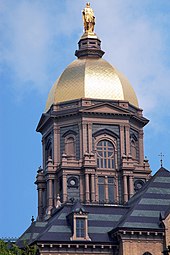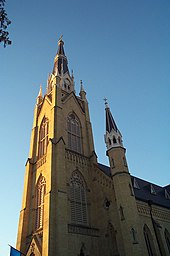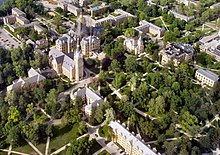University of Notre Dame
![]()
This article is about the university "Notre Dame" in Indiana (USA), for other universities of this name see Notre Dame University
The University of Notre Dame du Lac is a private Catholic university in the U.S. state of Indiana. It was founded in 1842 by the French priest Edward Sorin. It holds the highest research classification of American universities as R1 University with "very high research activity." Notre Dame has been recognized as one of the best universities in the United States, especially for undergraduate study. In rankings, Notre Dame competes with other elite universities such as Stanford, Yale, Northwestern, and Duke.
The campus is located in St. Joseph County near South Bend. The university is run by the Congregation of the Holy Cross. Landmarks include the Golden Dome, a domed structure with a gilded roof with a statue of Mary, Notre Dame Stadium, and the Basilica. It maintains a system of libraries, cultural institutions, and art and science museums, including the Hesburgh Library and the Snite Museum of Art. The majority of the university's 8,000 students live on campus in one of 31 residence halls, each with its own traditions, legacies, events, and intramural sports teams. The university's approximately 134,000 alumni are considered one of the strongest alumni networks in the United States.
The university offers more than 50 one-year study abroad programs and more than 15 summer programs. Notre Dame's graduate program includes more than 50 master's, doctoral, and professional degree programs offered by the six schools, including Notre Dame Law School and an MD-PhD program offered in combination with Indiana University School of Medicine. The University of Notre Dame is also known for its School of Architecture, an architecture faculty dedicated to teaching traditional or pre-modern architecture and urban planning (including in the spirit of New Urbanism). It annually awards the prestigious Driehaus Architecture Prize.
Under the leadership of Theodore Hesburgh, who was a friend of Martin Luther King, Notre Dame became a center for human rights in the United States. Until 1972, only men were admitted. Notre Dame's growth has continued into the 21st century. With a current endowment of $13.8 billion, it is among the top ten wealthiest universities in the United States.
Also well known is the library with the Dante collection and Zahm Hall in honor of Reverend John Augustine Zahm.

The Golden Dome

Basilica of the Sacred Heart, Church of the University and the Congregation of the Holy Cross

Main building from the air
History
Foundations
In 1842, the Bishop of Vincennes, Célestine Guynemer de la Hailandière, offered land to Edward Sorin of the Congregation of the Holy Cross (Latin: Congregatio a Sancta Cruce) on condition that he build a college in two years. Sorin arrived on the site on November 26, 1842, with eight Holy Cross friars from France and Ireland, and began the school with Stephen Badin's old log chapel. After the first students enrolled, they soon erected other buildings, including the Old College, the first church, and the first main building.
The task Rev. Sorin and his brothers faced was not an easy one: with little money (about $370), they had to administer to both the local Potawatomi (since they had inherited the mission with the land) and the local white Catholics (who were an underrepresented minority in a largely Protestant area) and find a college in two years at a time. Notre Dame began as an elementary and secondary school; in 1844 it received its official college charter from the Indiana General Assembly. According to the charter, the school is officially known as the University of Notre Dame du Lac (University of Our Lady of the Lake). Because the university was originally all-male, Saint Mary's College for women only was founded by the Sisters of the Holy Cross near Notre Dame in 1854. More students attended the college and the first degrees were awarded in 1849. Additionally, new buildings were added to the university, allowing more students and faculty to live, study, and eat at the university.
Early history
With each new president, new academic programs were offered and new buildings were constructed to accommodate them. The original main building, constructed by Sorin shortly after his arrival, was replaced in 1865 with a larger one that housed the university's administration, classrooms, and dormitories. Under William Corby's first administration, Notre Dame's enrollment grew to more than 500 students. In 1869 he opened the law school, which offered a two-year degree, and in 1871 he began construction of Sacred Heart Church, now the Basilica of the Sacred Heart, Notre Dame. Two years later Auguste Lemonnier opened a library in the main building; by 1879 it had reached 10,000 volumes.
This main building and the library collection were destroyed by fire in April 1879. The school was immediately closed and the students were sent home. Sorin, the university's founder, and William Corby, then president, immediately planned to rebuild the structure that housed virtually the entire university. Construction began on May 17, and through the incredible zeal of administrators and workers, the building was completed before the fall semester of 1879. The library collection was also rebuilt and remained in the new main building for years thereafter.
Growth
By 1890, individual dormitories had been built for students. William J. Hoynes was dean of the law school from 1883 to 1919, and when the new building opened shortly after his death, it was renamed in his honor. John Zahm became the Holy Cross Provincial for the United States and was charged with the overall supervision of the university. He sought to modernize and expand Notre Dame by constructing buildings and expanding the campus art gallery and library, amassing a famous Dante collection, and pushing Notre Dame to become a scientific research university. The community did not extend his tenure for fear that he would have expanded Notre Dame too quickly and put the order in serious debt.
The movement toward a research university was later supported by John W. Cavanaugh, who modernized educational standards and attracted many scholars to campus. In 1917, Notre Dame awarded its first degree to a woman and its first bachelor's degree in 1922, but female students did not become common until 1972.
In 1919, James A. Burns became president of Notre Dame; following in Cavanaugh's footsteps, in three years he brought about an academic revolution that raised the school to national standards by adopting the electoral system and moving away from the traditional scholastic and classical emphasis of the university. In contrast, Jesuit colleges, bastions of academic conservatism, were reluctant to move to an elective system. For this reason, their graduates were expelled from Harvard Law School. Notre Dame continued to grow over the years, adding more colleges, programs, and athletic teams.
By 1921, with the addition of the College of Commerce, Notre Dame had grown from a small college to a university with five colleges and a law school. It continued to expand, adding new dormitories and buildings with each successive president. By 1925, enrollment had grown to 2,500 students; nearly 1,500 of them lived on campus.
One of the main drivers of the university's growth was its football team, the Notre Dame Fighting Irish. Knute Rockne became head coach in 1918. Under Rockne, "the Irish" posted a record of 105 wins, 12 losses, and five ties. During his 13 years, the Irish won three national championships, had five undefeated seasons, won the 1925 Rose Bowl, and produced players like George Gipp and the "Four Horsemen." Knute Rockne has the highest winning percentage (.881) in NCAA Division I / FBS history. Rockne's offenses used the Notre Dame box and his defense ran a 7-2-2 scheme. The last game Rockne coached was on December 14, 1930, when he led a group of Notre Dame all-stars against the New York Giants in New York City.
Notre Dame's success reflected the rising status of Irish-Americans and Catholics in the 1920s. Catholics gathered around the team and listened to the games on the radio, especially when they defeated teams from schools that symbolized the Protestant establishment in America-Harvard, Yale, Princeton, and Army.
Its role as a high-profile flagship institution of Catholicism made it an easy target of anti-Catholicism. The most notable episode of violence was a 1924 clash between Notre Dame students and the Ku Klux Klan (KKK), a white supremacist and anti-Catholic movement. Nativism and anti-Catholicism, especially when directed at immigrants, were cornerstones of KKK rhetoric, and Notre Dame was seen as a symbol of the threat posed by the Catholic Church. The Klan opted for a week-long klavern in South Bend. Clashes with the student body began on May 17 when students, aware of anti-Catholic hostility, prevented Klansmen from disembarking from their trains at South Bend Station and tore up KKK clothing and insignia. Two days later, thousands of students gathered downtown to protest the Klavern, and only the arrival of college president Matthew Walsh prevented further clashes. The next day, Rockne spoke at a rally on campus, imploring students to obey Walsh and refrain from further violence. A few days later, the Klavern disbanded, but hostility toward the students contributed to the demise of the KKK in Indiana.
Expansion in the 1930s and 1940s
Charles L. O'Donnell (1928-1934) and John Francis O'Hara (1934-1939) promoted both physical and academic expansion. During their tenure at Notre Dame, they brought numerous refugees and intellectuals to campus; such as W. B. Yeats, Frank H. Spearman, Jeremiah D. M. Ford, Irvin Abell, and Josephine Brownson for the Laetare Medal, established in 1883. O'Hara also focused on expanding graduate school.
New construction included Notre Dame Stadium, the law school building, Rockne Memorial, numerous residence halls, Cushing Hall of Engineering, and a new heating plant. This rapid expansion, which cost the university more than $2.8 million, was made possible in large part by football revenues. O'Hara strongly believed that the Fighting Irish football team could be an effective means of "acquainting the public with the ideals that dominate Notre Dame." He wrote, "Notre Dame football is a spiritual ministry because it is played for the honor and glory of God and His Blessed Mother. When St. Paul said, 'Whether you eat or drink or whatever you do, do it all for the glory of God,' he included football."
John J. Cavanaugh served as president from 1946 to 1952. He devoted his efforts to raising academic standards and transforming the university's administration to better serve its expanded educational mission and an expanded student body. He also emphasized advanced study and research while quadrupling the University's student population, with undergraduate enrollment? increasing by more than half and graduate enrollment? increasing fivefold. Cavanaugh also founded the Lobund Institute for Animal Studies and Notre Dame's Medieval Institute. Cavanaugh also directed the construction of Nieuwland Science Hall, Fisher Hall, and the Morris Inn, as well as the Hall of Liberal Arts (now O'Shaughnessy Hall), made possible at the time by a donation from I.A. O'Shaughnessy the largest ever made at an American Catholic university. He also established the university's advisory board system.
Hesburgh Era: 1952-1987
Theodore Hesburgh was president for 35 years (1952-1987), and under his presidency Notre Dame experienced tremendous growth and transformation from a school known primarily for its football to a premier university, an academic powerhouse, and a preeminent Catholic university. During that time, the annual operating budget increased by a factor of 18 from $9.7 million to $176.6 million, the endowment increased by a factor of 40 from $9 million to $350 million, and research funding increased by a factor of 20 from $735,000 to $15 million. Enrollment nearly doubled from 4,979 to 9,600, faculty more than doubled from 389 to 950, and degrees awarded annually doubled from 1,212 to 2,500.
Hesburgh also made Notre Dame coeducational. Women had graduated every year since 1917, but it was mostly religious sisters in degree programs. In the mid-1960s, Notre Dame and Saint Mary's College developed a joint exchange program in which several hundred students took courses not offered at their home institution. This arrangement added women to a campus that already had several women in graduate schools. After extensive debate, the merger with St. Mary's was rejected, largely because of the difference in faculty qualifications and salary levels. "In American college education," explained Charles E. Sheedy, dean of arts and letters at Notre Dame, "certain characteristics that were once considered advantageous and enviable are now regarded as anachronistic and out of place. ... In this environment of diversity, integration "of the sexes is a normal and expected aspect that replaces separatism. " Thomas Blantz, Notre Dame's vice president for student affairs, added that coeducation "opened up a whole different pool of very bright students." Two of the residence halls were converted for the newly admitted female students in their first year, and two more converted the next school year. In 1971, Mary Ann Proctor, a transfer from St. Mary's, became the first female student. The following year, Mary Davey Bliley became the first woman to graduate from the university with a bachelor's degree in marketing. In 1978, a historic district with 21 contributing buildings was listed on the National Register of Historic Places.
Recent history
During the 18 years Edward Malloy was president, the school's reputation, faculty, and resources grew rapidly. He added more than 500 professors and the academic quality of the student body improved dramatically, with the average SAT score rising from 1240 to 1460. The number of minority students more than doubled, and the endowment increased from $350 million to more than $3 billion. The annual operating budget increased from $177 million to over $650 million, and annual research funding improved from $15 million to over $70 million.
Notre Dame's most recent capital campaign (2014) raised $2.014 billion, far exceeding its goal of $767 million. It was the largest in the history of Catholic higher education and the largest of any university without a medical school at the time.
The Rev. John I. Jenkins succeeded Malloy in 2005. In his inaugural address, Jenkins described his goals of making the university a leader in research, recognizing ethics, and connecting faith and study. During his tenure, Notre Dame has increased its endowment, expanded its student body and undertaken numerous construction projects on campus, including the Compton Family Ice Arena, a new architecture building, additional residence halls and Campus Crossroads, a $400 million expansion and addition to Notre Dame Stadium.
Rankings
The university regularly ranks among the top 20 universities in the United States (as ranked by U.S. News and World Report, Forbes, and USA Today). The Philosophical Gourmet Report (2014-2015) ranks the University of Notre Dame du Lac as the best university in the subjects of philosophy of religion, philosophy of the Middle Ages, and philosophy of mathematics in the entire English-speaking world. In addition to philosophy and theology, Notre Dame is also particularly known for the Mendoza College of Business. In 2010, 2011, and 2012, the Mendoza College of Business topped Bloomberg Businessweek's annual ranking of "Best Undergraduate Business Schools." For 2020, Notre Dame ranked 11th for undergraduate education, 24th for best value school, and 15th among "national universities" in the U.S. in U.S. News & World Report's Best Colleges report.
Questions and Answers
Q: What is the University of Notre Dame?
A: The University of Notre Dame refers to a private Catholic university located near South Bend, Indiana. It was founded in 1842 by Father Edward Sorin of the Congregation of Holy Cross.
Q: Who founded the University of Notre Dame?
A: The University of Notre Dame was founded by Father Edward Sorin of the Congregation of Holy Cross.
Q: When was the University of Notre Dame founded?
A: The University of Notre Dame was founded in 1842.
Q: Was the University of Notre Dame originally an all-male school?
A: Yes, in the beginning, the University of Notre Dame was an all-male school.
Q: When were females first admitted to the University of Notre Dame?
A: Females were first admitted to the University of Notre Dame in 1972.
Q: How many colleges and professional schools does Notre Dame have?
A: Notre Dame has five colleges and one professional school.
Q: What are the athletic teams of the University of Notre Dame called?
A: The athletic teams of the University of Notre Dame are known as the Fighting Irish.
Search within the encyclopedia